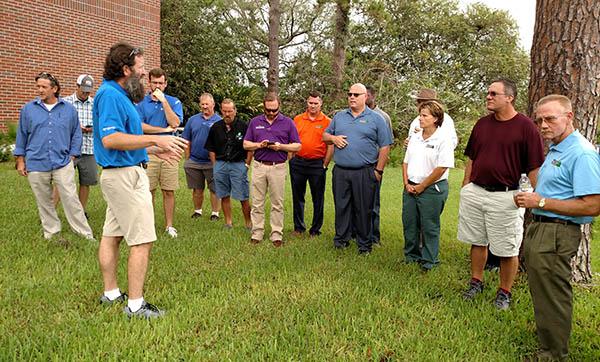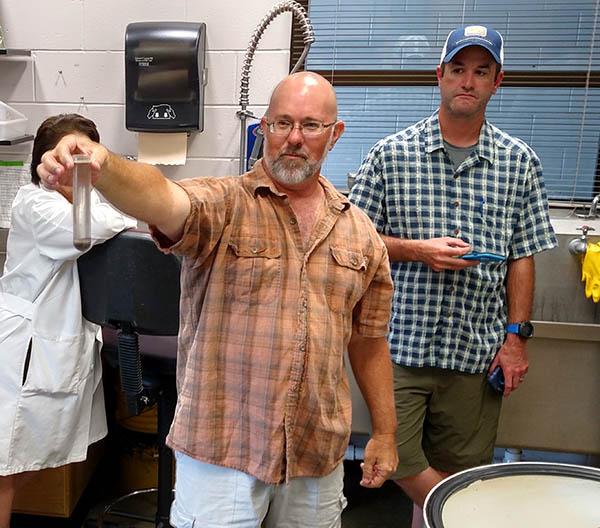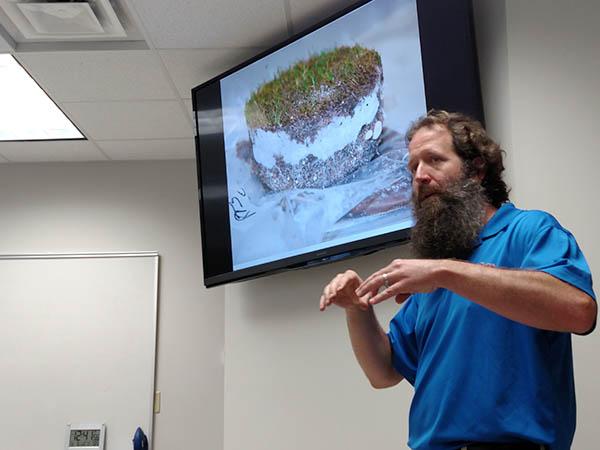
Ben Franklin is credited with saying "Tell me and I forget, teach me and I may remember, involve me and I learn."
 His words are as poignant now as they were in the 18th century, and that philosophy is the basis for a hands-on learning experience that professors at the University of Florida Institute of Food and Agricultural Sciences are bringing to turf managers across the state.
His words are as poignant now as they were in the 18th century, and that philosophy is the basis for a hands-on learning experience that professors at the University of Florida Institute of Food and Agricultural Sciences are bringing to turf managers across the state.The two-day Evidence-Based Turf Management workshop includes a mix of classroom lecture followed by hands-on learning in a laboratory or field environment. Part I, held last year at the university's research station in Fort Lauderdale, focused on the role of water, light, temperature and nutrition in turf management. Part II, held recently at the main campus in Gainesville, focused on managing pests, namely weeds, pathogens, insects and nematodes, with a half day devoted to each.
"One of the cool things is we enforce lectures with hands-on experience. We spend time in the laboratory looking through a microscope looking at plants with diseases and scraping those leaf surfaces and look at them under the microscope and identify them, and then we come back and reinforce that with some lecture content," said Bryan Unruh, Ph.D., professor of environmental horticulture, extension specialist and assistant director at UF's West Florida Research and Education Center in the Panhandle town of Jay.
"Because it is a two-day event, we are able to dig in deeper. We still provide education at state conferences and regional seminars and industry meetings. Those are good, but you can only go so far in one hour. Here, we have two days digging in and digging in deep. It's cool to see light bulbs go off and have 'aha' moments when attendees connect field experience with what they are seeing in a lab."
Instructors in the pest management workshop were weed scientist Jay Ferrell, Ph.D., turf pathologist Phil Harmon, Ph.D., entomologist Adam Dale, Ph.D., and nematologist Billy Crow, Ph.D., who gave a primer on nematodes that are commonly found in finely managed turfgrass in Florida.
Because it is a two-day event, we are able to dig in deeper. We still provide education at state conferences and regional seminars and industry meetings. Those are good, but you can only go so far in one hour. Here, we have two days digging in and digging in deep."
That session also included a visit to the nematode lab, where workers there demonstrated how to extract nematode samples from soil before they can be identified. Attendees then prepared their own lance nematode samples for viewing under the microscope. He also led a demonstration in which his "students" used forceps to coax female root knot nematodes from galls on the leaf surface of turf samples.
"The primary objective was to teach attendees about the major types of nematodes that affect turf, recognize the symptoms of different types of nematodes, take samples and interpret the results," Crow said. "It is important to make the correct identification so you can pick the right control method for the specific nematodes you have."
Ferrell kicked off the workshop with a brief history of herbicides, a lecture on how they work and why some work better than others. Visitors to Phil Harmon's lab in Fifield Hall went into the yard outside the building for some quick in-the-field disease diagnosis and retreated inside to learn the differences between some common turf pathogens. That workshop also included preparing and viewing samples under a microscope for the purpose diagnosing pathogens such as sclerotinia homeocarp, rhizoctonia, curvularia and Pythium.
All lessons and findings shared with attendees are supported by published peer-reviewed research.
"When we set out to do these evidence-based turf management workshops, we get published research behind them," Unruh said. "These are not our opinions or ideas, these are facts."
 The emphasis on correct diagnosis of a pest problem was an overarching theme throughout each of the four presentations.
The emphasis on correct diagnosis of a pest problem was an overarching theme throughout each of the four presentations."Correct diagnosis is the first step to effective control," Dale said.
His presentation covered some of the most common insect pests in Florida turfgrass. And although superintendents in other parts of the country might never have to worry about control methods for southern mole crickets, the basic tenets of Dale's presentation transcend geography and insect species.
"All pests directly interact with temperature, water, plant stress. Anything that makes the landscape what it is has an effect on insect pests," Dale said. "The keys to pest management are: what is the host, how does the pest feed, what is its lifecycle. All these things tell you how to treat, with what and when."
He offered a five-step process to implementing a successful IPM plan for insect pest management.
> know what problem is;
> track the problem, monitor pests and damage;
> decide when to act;
> select a specific IPM;
> evaluate progress.
"There was a need across the state for more information. We put our brains together and came up with an event that provided greater value than a traditional turf conference," said Travis Shaddox, Ph.D., assistant professor of turfgrass science and extension specialist at UF's Fort Lauderdale Research and Education Center. "We felt we could provide experiential value, looking under a microscope and going out into the field to support a lecture."

